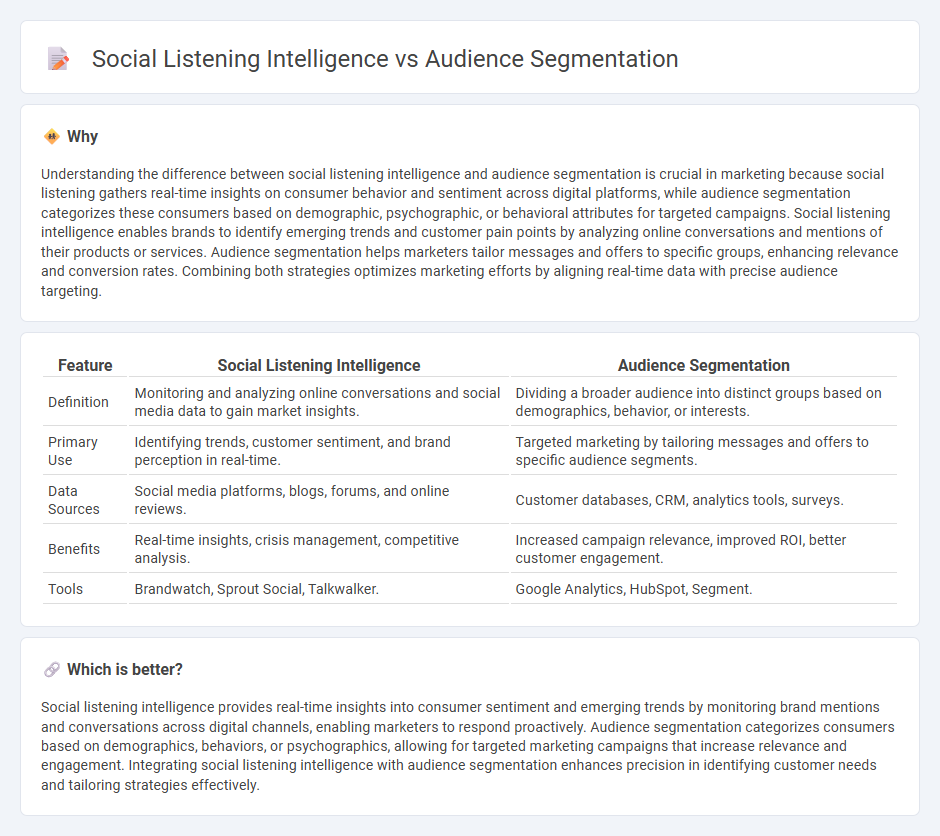
Social listening intelligence captures real-time consumer sentiments and emerging trends by analyzing online conversations across social media platforms, enabling brands to respond swiftly to market changes. Audience segmentation divides consumers into distinct groups based on demographics, behaviors, and preferences to tailor marketing strategies effectively. Discover how integrating these approaches can elevate your marketing precision and drive engagement.
Why it is important
Understanding the difference between social listening intelligence and audience segmentation is crucial in marketing because social listening gathers real-time insights on consumer behavior and sentiment across digital platforms, while audience segmentation categorizes these consumers based on demographic, psychographic, or behavioral attributes for targeted campaigns. Social listening intelligence enables brands to identify emerging trends and customer pain points by analyzing online conversations and mentions of their products or services. Audience segmentation helps marketers tailor messages and offers to specific groups, enhancing relevance and conversion rates. Combining both strategies optimizes marketing efforts by aligning real-time data with precise audience targeting.
Comparison Table
| Feature | Social Listening Intelligence | Audience Segmentation |
|---|---|---|
| Definition | Monitoring and analyzing online conversations and social media data to gain market insights. | Dividing a broader audience into distinct groups based on demographics, behavior, or interests. |
| Primary Use | Identifying trends, customer sentiment, and brand perception in real-time. | Targeted marketing by tailoring messages and offers to specific audience segments. |
| Data Sources | Social media platforms, blogs, forums, and online reviews. | Customer databases, CRM, analytics tools, surveys. |
| Benefits | Real-time insights, crisis management, competitive analysis. | Increased campaign relevance, improved ROI, better customer engagement. |
| Tools | Brandwatch, Sprout Social, Talkwalker. | Google Analytics, HubSpot, Segment. |
Which is better?
Social listening intelligence provides real-time insights into consumer sentiment and emerging trends by monitoring brand mentions and conversations across digital channels, enabling marketers to respond proactively. Audience segmentation categorizes consumers based on demographics, behaviors, or psychographics, allowing for targeted marketing campaigns that increase relevance and engagement. Integrating social listening intelligence with audience segmentation enhances precision in identifying customer needs and tailoring strategies effectively.
Connection
Social listening intelligence collects real-time data from social media platforms, enabling marketers to identify trends, customer sentiments, and emerging needs. This data enhances audience segmentation by refining demographic, psychographic, and behavioral profiles, allowing for more precise targeting and personalized marketing campaigns. Integrating social listening with audience segmentation improves campaign effectiveness by aligning messaging with actual consumer preferences and market dynamics.
Key Terms
Demographics
Audience segmentation uses demographics like age, gender, income, and location to categorize consumers into distinct groups for targeted marketing strategies. Social listening intelligence analyzes conversations and trends across social media to gain insights into audience behaviors and preferences beyond basic demographics. Explore more about leveraging both methods to refine your marketing efforts effectively.
Psychographics
Audience segmentation using psychographics categorizes consumers based on values, attitudes, lifestyles, and personality traits, providing deep insights into motivation and behavior patterns. Social listening intelligence analyzes real-time online conversations and sentiment, revealing authentic psychographic data through consumer language, preferences, and emotional expressions. Explore how combining psychographic audience segmentation with social listening intelligence can optimize targeted marketing strategies.
Sentiment analysis
Audience segmentation categorizes consumers based on demographics, behaviors, and preferences, enabling targeted marketing strategies. Social listening intelligence, with a focus on sentiment analysis, monitors real-time online conversations to gauge public emotions and opinions about brands or products. Explore how integrating sentiment-driven social listening enhances audience insights and marketing effectiveness.
Source and External Links
What is Audience Segmentation? The 5 Main Types & Examples - This article discusses audience segmentation, outlining eight types including demographic, behavioral, psychographic, and more, with examples of effective segmentation strategies.
Audience Segmentation Guide: Types and Steps - This guide provides an overview of audience segmentation, including types such as demographics and behaviors, with steps for implementation.
How to Do Audience Segmentation - This resource explains the process of audience segmentation as a key activity within audience analysis, highlighting its importance for targeted communication strategies.
 dowidth.com
dowidth.com